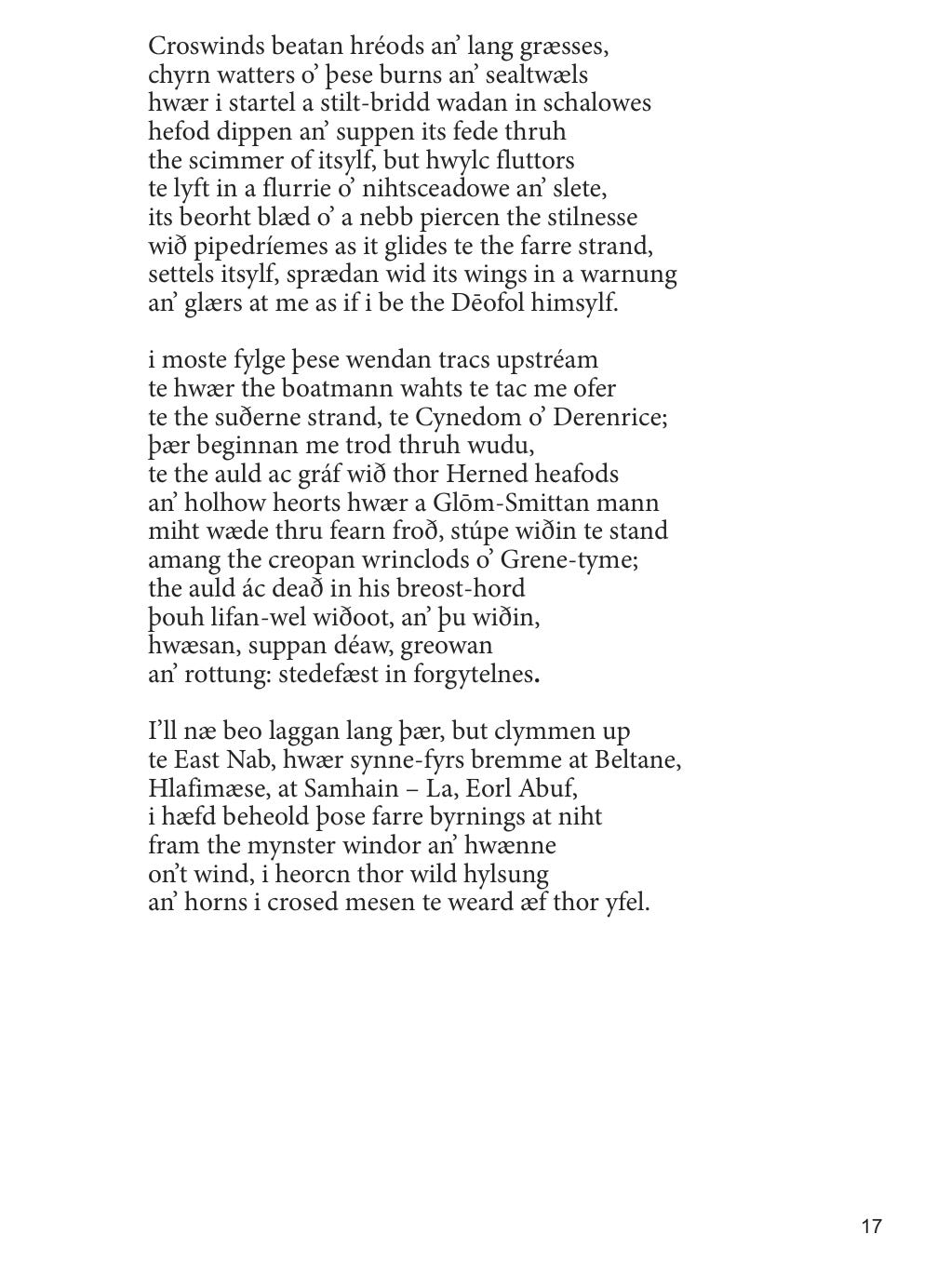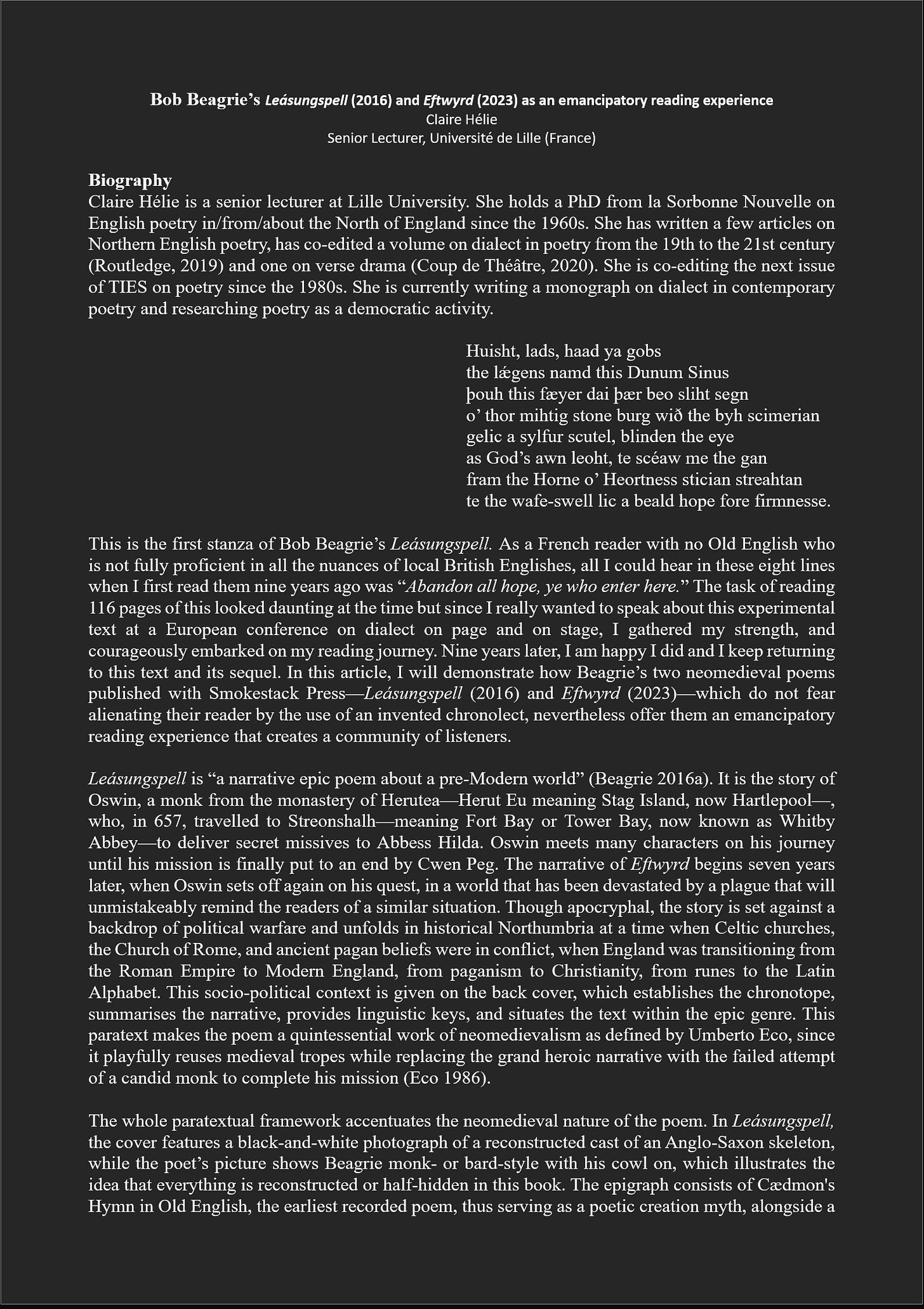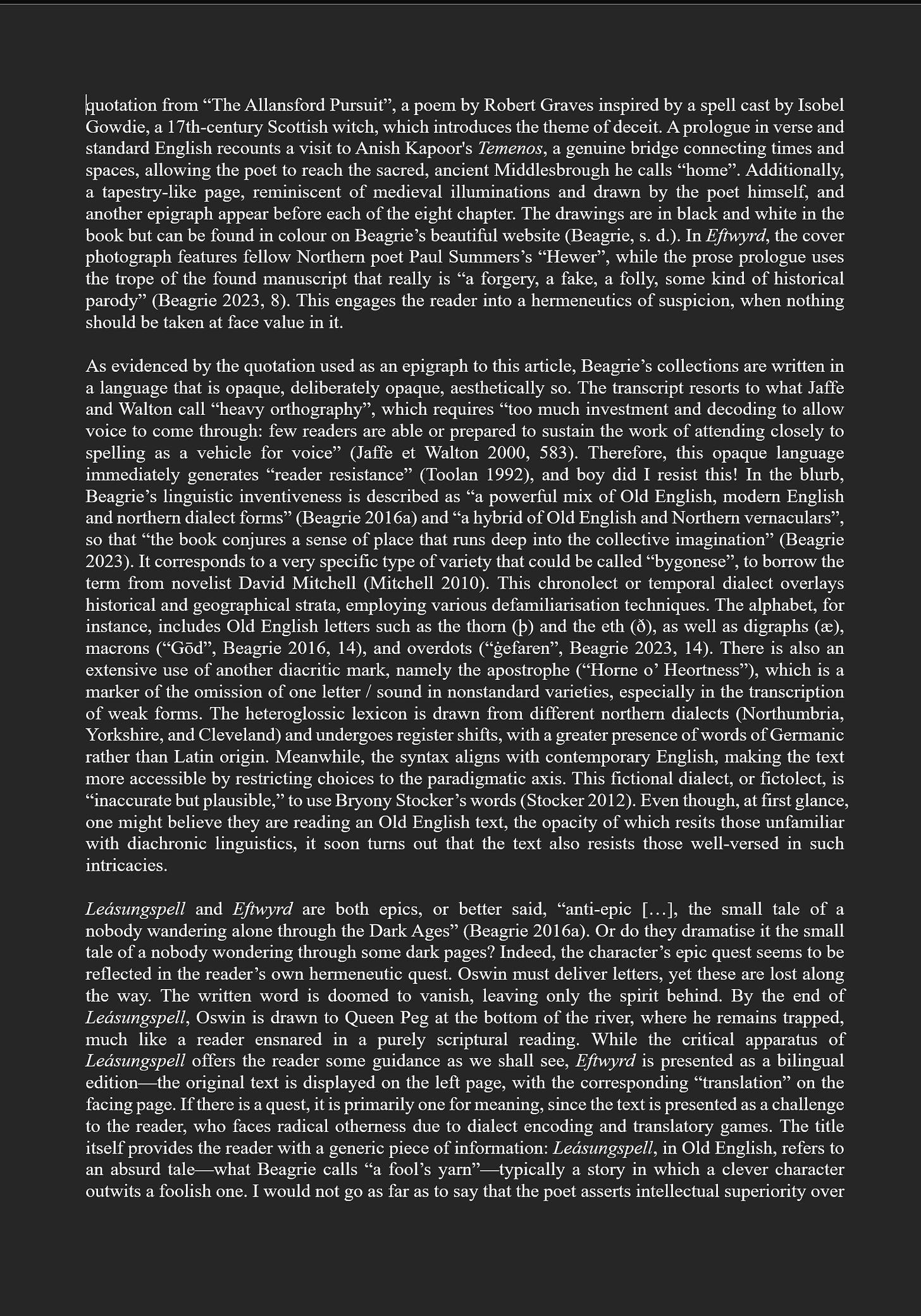The Starbeck Orion Issue #8 A Festschrift of Bob Beagrie, Page 23 of 25
A Feast Of Words And Image
https://on.soundcloud.com/usoLKiuCBJZ6SAZr9
Here are some more extracts from Leasungspell on Soundcloud:
Part 2
https://on.soundcloud.com/Qbn5nc1yE8BiWBdc9
Part 3
https://on.soundcloud.com/Z8sbFBgik1qFKpvX7
Part 4
https://on.soundcloud.com/VnWJWpWbKaCcw1C39
Part 5
https://on.soundcloud.com/1wdCsWJGNaJ8PdzH7
Part 6
https://on.soundcloud.com/vfic4G3dnEcYP5he6
Part 7
https://on.soundcloud.com/cqGzFcPNUms9qJUv6
Part 8
https://on.soundcloud.com/rPqQHoG2Sp23wzuX9
The Festschrift Interview
Q:18.1. Why did you put Leasungspell and Eftwyrd after Romanceros order wise?
It makes sense for those two books to be linked, with Eftwyrd following Leasungspell as they are two parts of the same story, even though there is a gap of seven years between them. Why after Romanceros? To be perfectly honest I don't really know. The Hand of Glory poems need to come last as they belong to the next collection so I suspect it's because they, together, represent the most ambitious and probably the most significant pieces of writing I've published.
Q:19. How did the story of Oswin emerge in your mind?
In 2003 I was Writer in Residence on The Hartlepool Headland, I love this little place, it has a lot of character and an incredible history. As part of the research, I read about St Hilda's monastery there in the mid 7th Century. It fascinated me and the whole idea of King Oswui granting Hild the land at Whitby for an Abbey if he was victorious against King Penda of Mercia, fired up my imagination. But it lay dormant for a long time. A good few years later Lou (my wife) organised an opportunity for us both to climb the transporter bridge on an open day. A brilliant somewhat scary experience with an amazing view. I wrote a poem about it called Transported which among other things imagines an Anglo Saxon monk waiting to cross the river on a small ferry boat on his way from Hartlepool to Whitby. That triggered a chain of creative ideas and I returned to the early history texts to start building up the context for this monk's journey.
Q:19.1: The description in "Unearthing The Epic" sounds very novelistic. What urged you to make it into an epic poem?
I thought it would be more authentic as an epic poem, and I read Beowulf, the Wanderer, The Seafarer, The Battle of Maldon, The Battle of Brunanbruh, Y Gododdin. The tradition of narrative verse from the period was there to experiment with so it offered an exciting model to explore.,
Q:20. What made you sure that Leasungspell needed a sequel?
I thought Leasungspell was done and dusted and the story complete. Then in 2020 I reread it as part of the research, analysis and reflections for my PhD thesis. While discussing it's style, structure and storyline and particularly the symbolism of the ending I suddenly had a brain-wave, it was like a slap in the face, with the big question booming in the caverns of my skull, 'What if he didn't drown?'
With that my synapses started firing and I could see the rough outline of the sequel, the second part of the journey I realised his arrival at Whitby should coincide with the famous synod. This meant it was after a seven year sojourn in the River Tees with Peg Powler, which echoes Odysseus's stay with Calypso before he resumes his journey. Coincidentally the publication of Leasungspell and Eftwyrd is also separated by seven years. What's more, in the year 664 there was a terrible sickness that ravaged parts of Britain and as we had recently come out of the Covid pandemic it was a perfect opportunity to play with pan temporal parallelism and explore some of those societal tensions..
Claire Helie On Bob
Oz Hardwick on Bob
Harry Man on Bob
Amazed by the power of his own divinations and to look for peace from them, Merlin or Myrddin, King Arthur’s great enchanter, is said to have disappeared for a time into the woods. It was here where he wanted to try to outlive their power. This, at least, is what we see in Taliesin’s telling of it. During Myrddin's retreat, Taliesin goes to see his friend and notes how Myrddin uses the same words for the “ashy spears” of leaves falling in autumn as he does for those warriors in his visions who will one day leave the world in battle. It is this animation of events we see in Bob Beagrie’s poems, most recently evident in the commemoration of Teesside’s International Brigade volunteers as, during intense fighting, they watch pages of great poetry, history and philosophy in a university library in Madrid erupt into snow around them, pages into which their own lives are becoming written.
Books of poetry span a panoply of subjects always with a keen eye on history and the human stories of personal witness that have too often been left untold, moving from the rat infested hammocks of Cook's HMS Endeavour, to the cobblestone backstreets of Linnanmäki, to prayers to Minerva remembered by the sandstone blocks on a Thornaby building site, to Brother Oswin’s epic journey quickened into the mind’s eye by a playful and electrifying hybridised Anglo Saxon dialect that is in of itself a kind of re-enchantment of the sound of old Northumbrian-Deiran language. Think of this list, then add to it the plays and spoken word, and journalism (and I am certain, more besides). Given how prolific Bob Beagrie has been as a writer, I would not be surprised if by now, they have had to create a new number for his works in the Dewey decimal system. Even this though – take another deep breath – is not the full story.
Throughout Bob’s career he has been a sensitive, inspiring, intellectual and energetic advocate for literature in Middlesbrough and throughout the Tees Valley creating a track record that is entirely in a league of its own. Bob’s editorship of KENAZ, his work in literature development, his event management, his completely magnetic skills as a workshop leader have led to school pupils returning to him as students and again as seasoned adults. His former students’ work graces the catalogues of established indie presses and major publishing houses as well as newspaper columns and the walls of contemporary art galleries the length and breadth of the land. Bob’s energy and versatility as a performer make his appearances an event in their own right.
I feel very humbled to know Bob and I cannot think of another writer who is thought of so fondly, so respectfully and so widely, by so many people. During their time together Taliesin and Myrddin exchange ‘awen’ known in Welsh to be a kind of flow of poetic inspiration from bard to bard. The awen is something both of the outside places of woodpecker forest silences and holloways, of commemoration and celebration and the wind ridden eddies and grooves on a lake’s surface, and the inner place too of too of oxygen and lungs and the imagination; of the breath of nature that poets both shape and are shaped by. In their exchange the awen carries their words so that they become known in the world. I hope too that Bob’s writing will continue to be more widely known, as Myrddin says in the close of their dialogue, to paraphrase, "that the truth of them will be heard".
Harry Man’s Lift (Tall Lighthouse, 2014) won the UNESCO Bridges of Struga Award. His co-collection authored with Endre Ruset, Deretter (‘Thereafter’, Flamme Forlag, 2021) won the Stephen Spender Prize and was a Dagblaget and Broken Sleep Books Book of the Year. He was shortlisted for Tees Valley Artist of the Year 2024. His first collection Popular Song (2024) is published by Nine Arches Press. He has translated Endre Ruset’s poetry collection Noriaki into English which is available from Broken Sleep Books. www.manmadebooks.co.uk
A review of Leasungspell
https://readdurhamenglish.wordpress.com/2017/10/23/cunning-and-art-review-of-leasungspell-by-bob-beagrie/
















